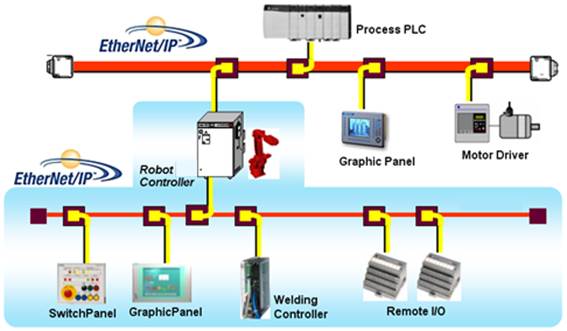1.2. Overview of EtherNet/IP
1.2. Overview of EtherNet/IP
EtherNet/IP is an Ethernet-based open industrial communication protocol developed by CI (ControlNet International) and ODVA (Open Device Vendor Association).
Diverse devices such as sensors, remote I/O, motor drivers, HMI, PLC and robot controllers in a factory can be connected through one single EtherNet/IP network regardless of manufacturers.

Figure 1.1 EtherNet/IP network
Depending on its communication functions, EtherNet/IP can be divided into 3 product groups, scanner class, adapter class, messaging class.
n Scanner class
The products of the scanner class are equivalent to existing fieldbus masters. They can request I/O data from EtherNet/IP adapters or EtherNet/IP scanners
n Adapter class
The products of the adapter class are equivalent to existing fieldbus slaves. They are the targets of the real time I/O data connection requested by scanners. Adapters can not send the real time I/O data for themselves without the help of scanners.
n Messaging class
The products of the messaging class are capable of sending and receiving explicit messages for the products of all classes, while they do not support the sending and receiving of real time I/O data. Examples include computer interface cards for uploading and downloading programs and network setting tools.